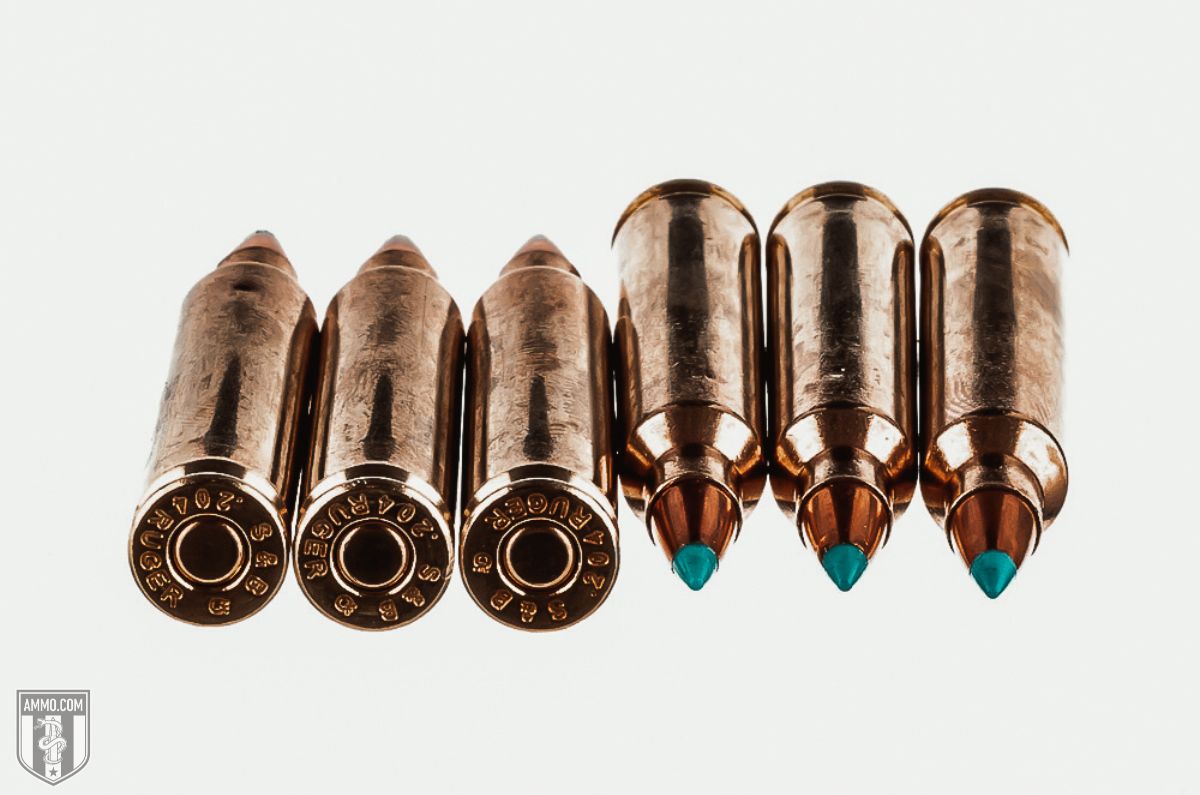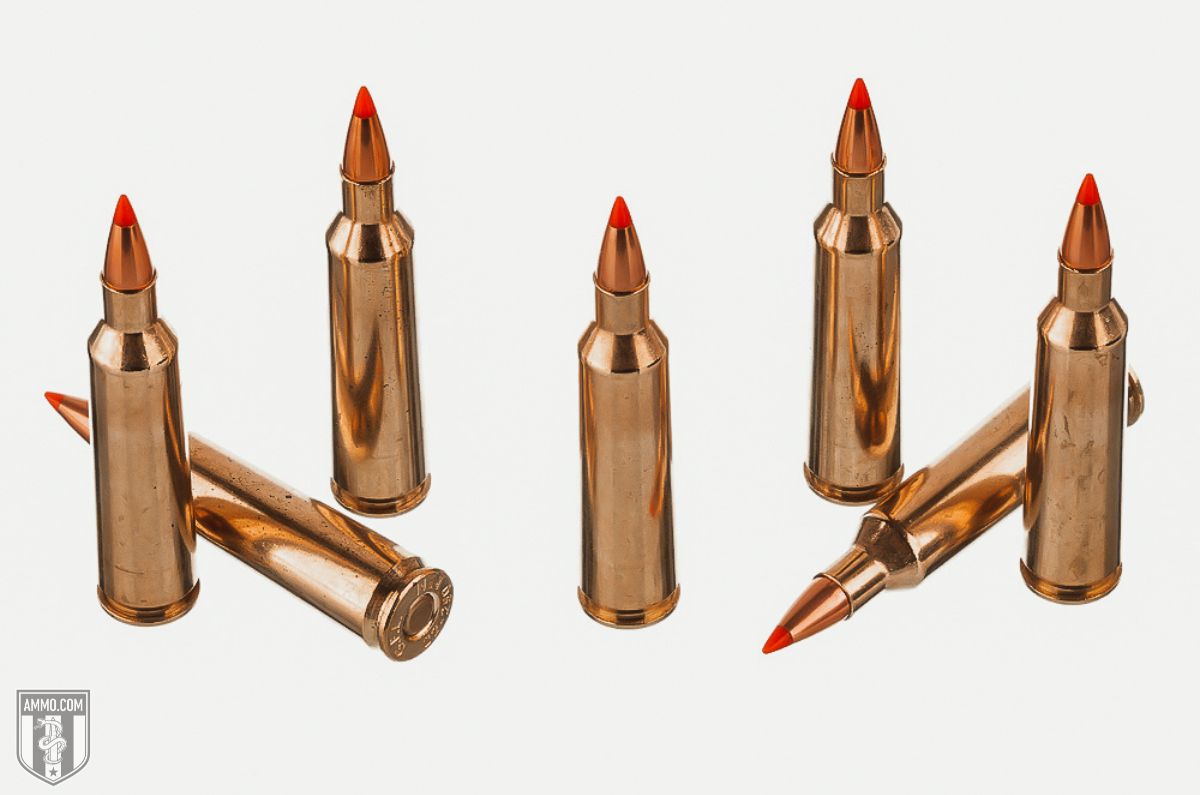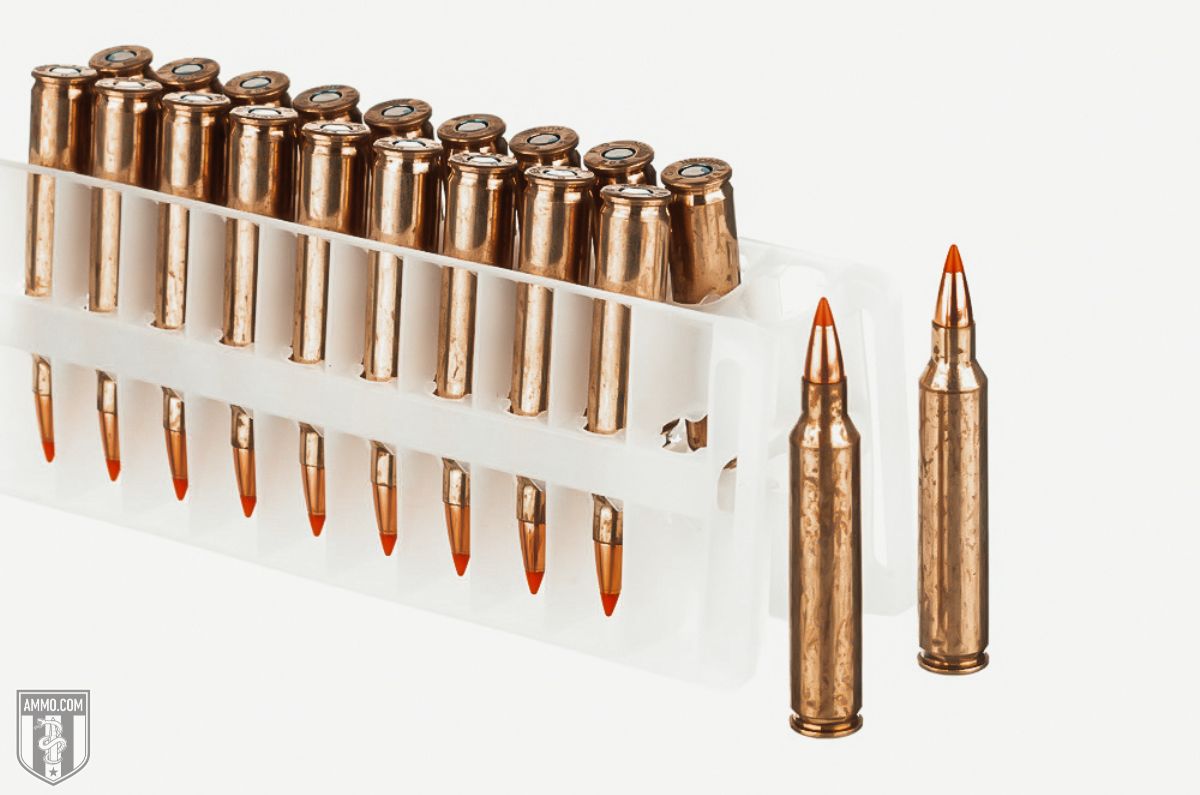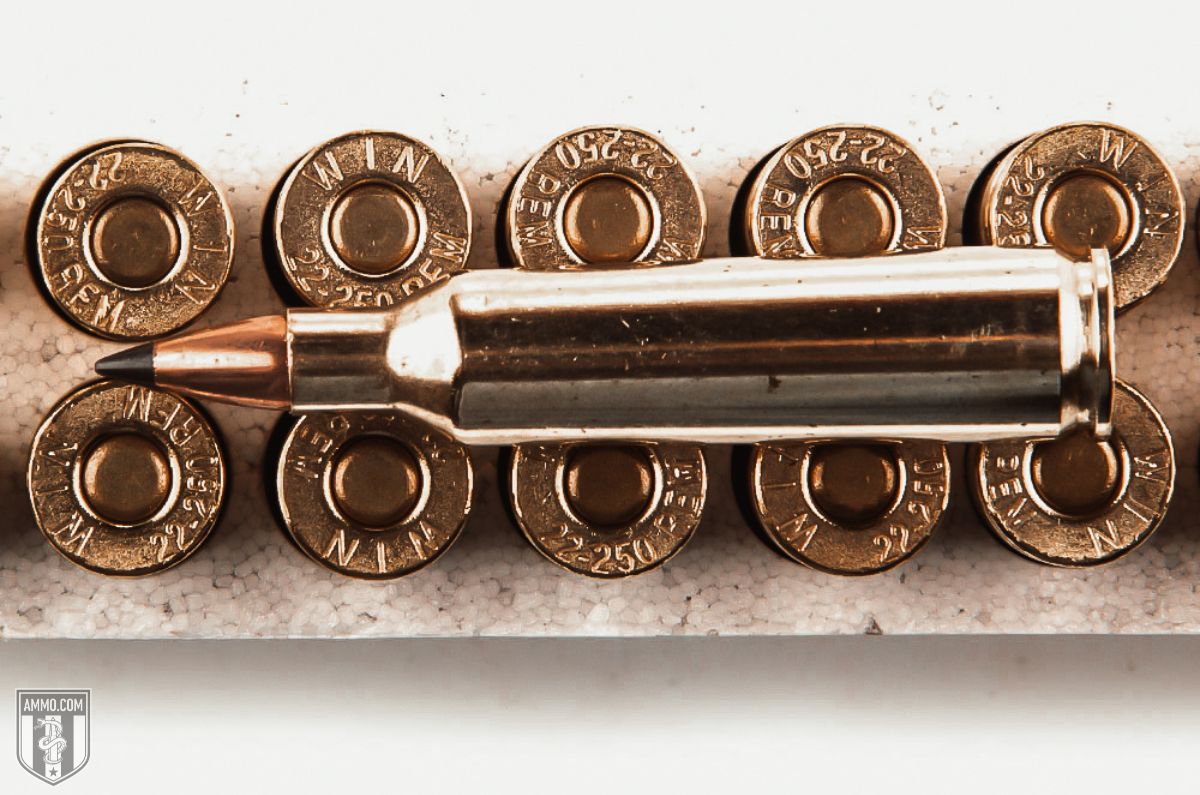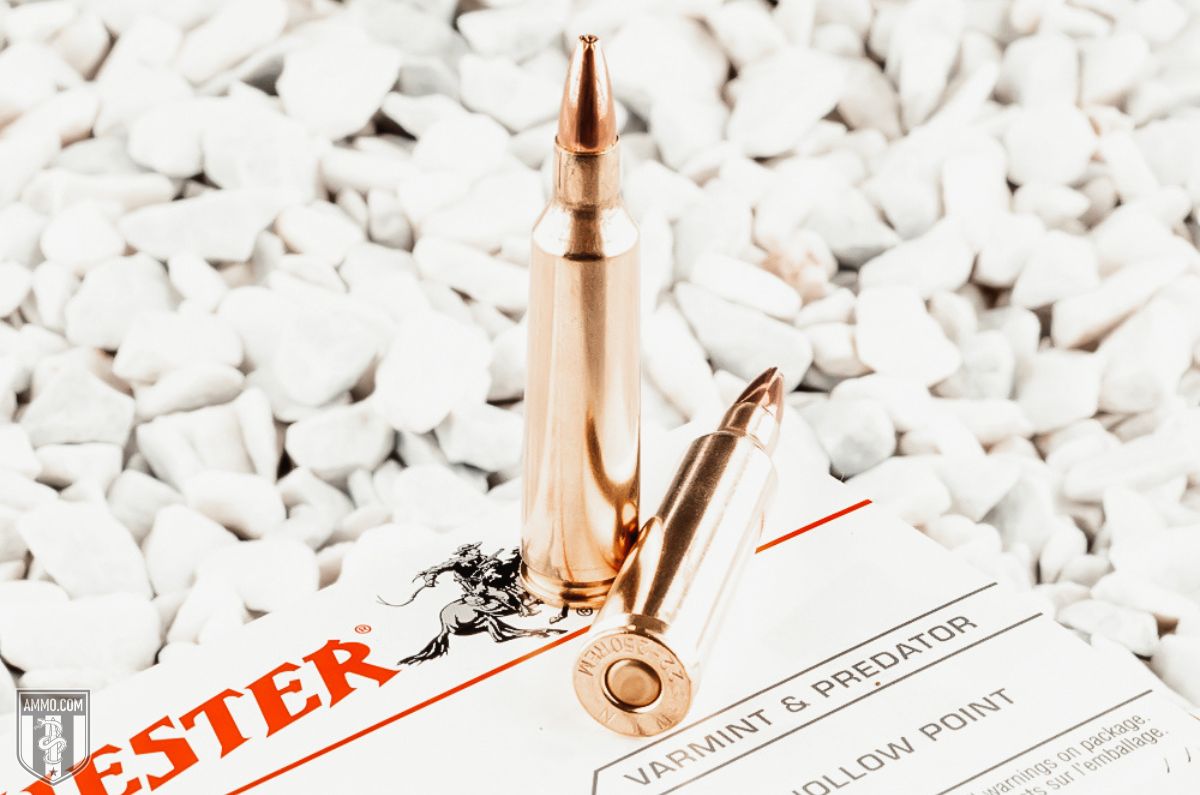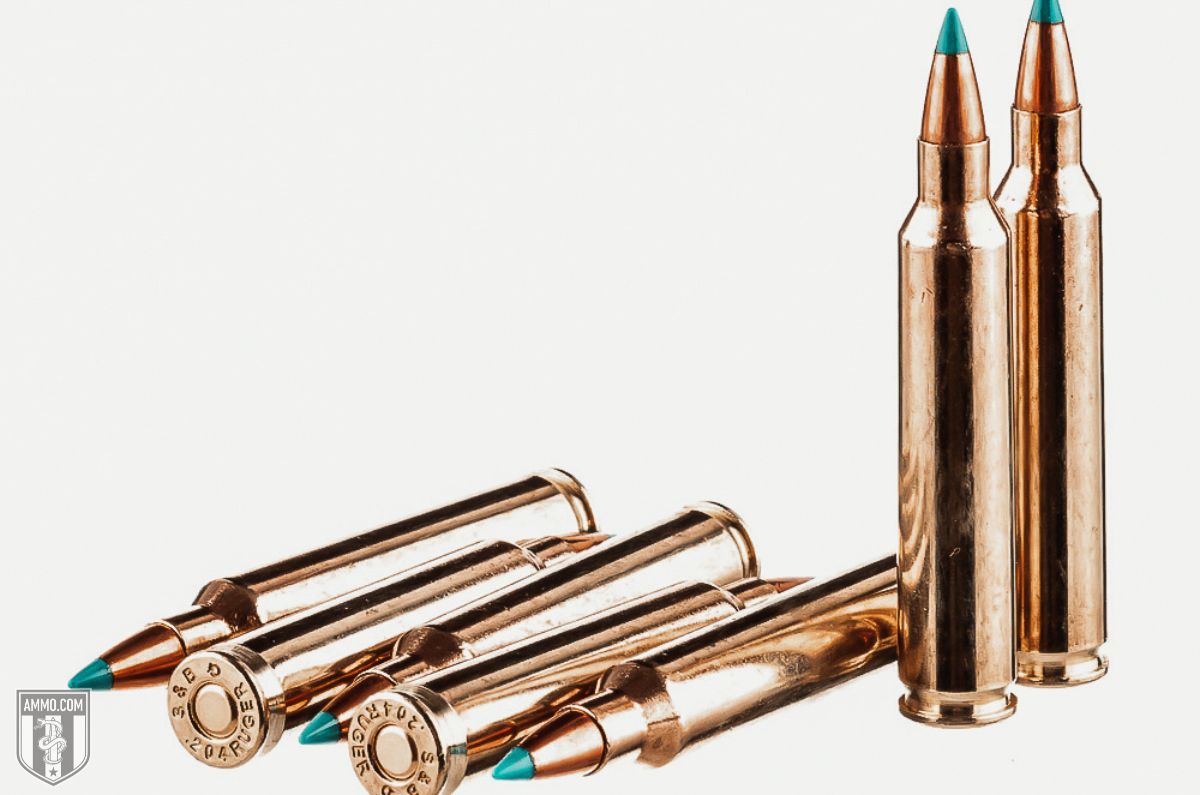204 vs 22 250: Coyotes' Worst Nightmare
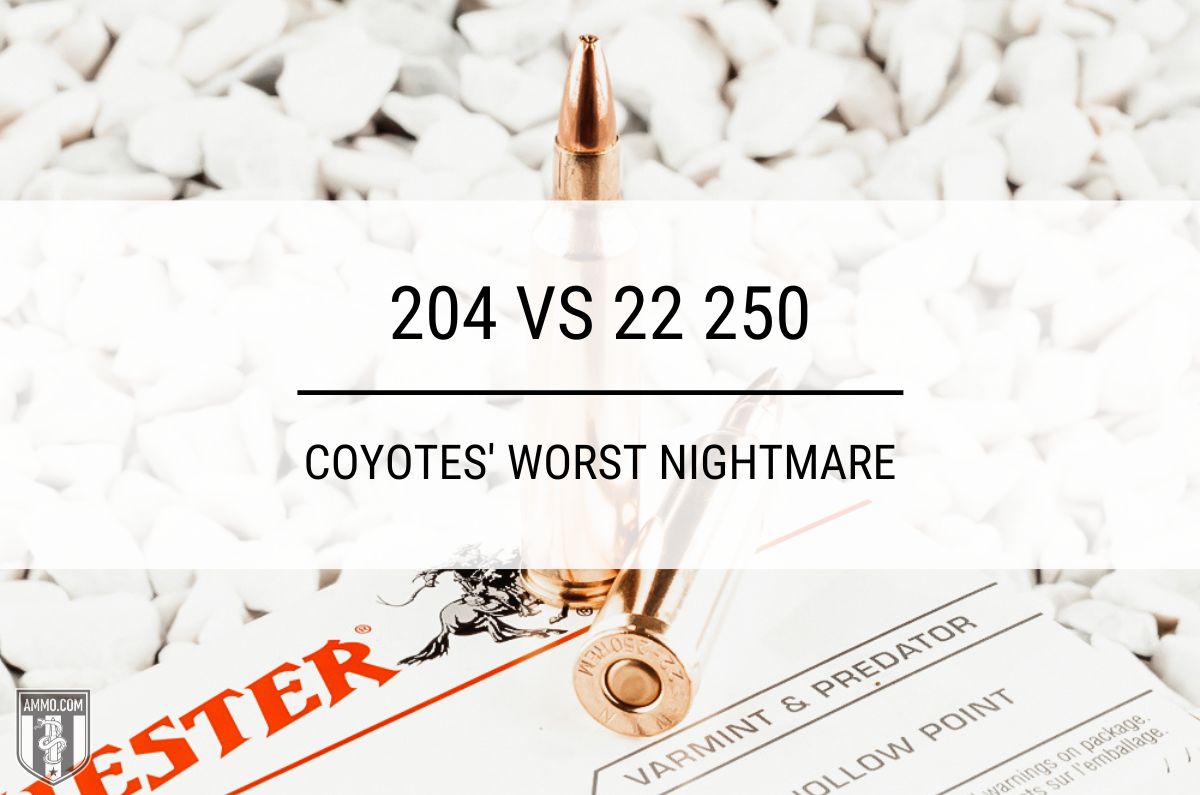
Even if you're new to varmint hunting, you've heard of the 204 Ruger and the 22 250 centerfire cartridges. They're two of the best coyote cartridges on the market.
While we know these calibers are better than many others in specific situations, how do they fair when pitted against each other?
Keep reading to see how the 204 vs 22 250 stacks up compared in ten critical categories.
204 vs 22 250
The 22 250 has had a devoted following for many decades, while the 204 Ruger is only a couple of decades old.
The following categories are what matter most to the average hunter and shooter. We will keep a tally of each section's winner and declare the winner in the conclusion.
Let's get started with a cartridge comparison!
Cartridge Specs
The 204 Ruger parent case is the 222 Remington Magnum necked down to 0.204". The shoulders were pushed forward slightly and increased the angle to 30 degrees.
The .250-3000 Savage necked down to accept 22 caliber bullets is the parent case for the 22-250.
The 204 has a base diameter of 0.3764", and the 22 250 has a base diameter of 0.47".
The neck diameter of the 204 Ruger is 0.2311" and 0.254" for the 22-250.
The 204 Ruger shoots a slightly smaller diameter bullet of 0.204", while the bullet diameter of the 22-250 is 0.224".
The case length for the 204 is 1.85", and the 22 250 has a slightly longer case length of 1.912".
The 204 Ruger has an overall length of 2.2598", and the 22-350 comes in at 2.35".
33.2 gr H2O is what to expect for the case capacity of the 204 Ruger, while the 22-250 has a case capacity of 44.6 grains.
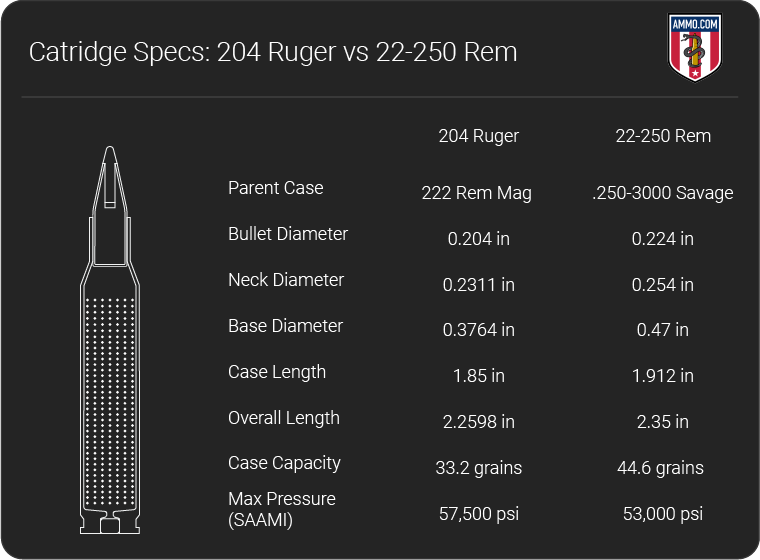
Lastly, the maximum pressure (SAAMI) for the 204 is 57,500 psi, and the 22-250's max pressure is 53,000 psi.
Recoil: 204 Ruger vs 22 250
Recoil is an essential consideration because a round with heavy recoil is more difficult to control and will slow the rate of follow-up shots.
Recoil is primarily affected by muzzle velocity (FPS), powder charge, bullet weight, and rifle weight.
Both calibers have very low recoil, but the 22-250 is almost double that of the 204 Ruger.
This might sound like a lot, but it's not much of a difference when you look at the numbers.
The 204 Ruger has 3.8 ft-lbs of free recoil when chambered in a typical 7lb rifle.
The 22-250 will have free recoil energy of 6.72 ft-lbs when fired from a 7lb rifle.
The winner is the 204 Ruger. Most shooters will notice a little difference, but neither caliber will leave your shoulder sore from shooting it, so don't let this be the determining factor.
Trajectory
The trajectory of the bullet is the bullet's path to the target. It is an arch because gravity pulls the bullet down.
To counteract gravity, a higher velocity is needed. When the bullet's velocity is increased, it will resist gravity for longer.
The trajectory is important to consider because it's easier to be more accurate with a flatter trajectory.
The trajectory will change when you use different bullets, so take these numbers lightly. They're only intended to give you an idea of what to expect from each caliber.
The 32 gr V-MAX load for the 204 has the flattest trajectory with only -31.8" of bullet drop at 500 yards.
At 500 yards, the 22-250 Rem 40 gr Nosler Ballistic Tip has a bullet drop of -36.2".
While both rounds have a relatively flat trajectory out to 500 yards, the 204 is capable of a flatter trajectory and wins this section.
Accuracy: 22 250 vs 204 Ruger
The accuracy of a round depends on many factors. The primary contributing factor is the shooter. If the shooter is comfortable with the firearm and understands the bullet's trajectory, they'll be reasonably accurate with it.
A few other factors are recoil, bullet trajectory, barrel twist rate, and even brand of ammo. Most rifles prefer a particular brand of ammo due to the bullet and rifle twist rate.
For the sake of argument, we will assume all factors that can be the same are the same, leaving recoil and trajectory as the primary contributing factors.
As we learned earlier, the 204 Ruger has less recoil and a flatter trajectory out to 500 yards.
This means the 204 Ruger is also the winner of this category. However, keep in mind how close the previous sections were and the fact that the 22-250 has been accurately used for decades.
The 22-250 is not an inaccurate round, but it is slightly less accurate than the 204 Ruger in the hands of the average shooter.
Ballistic Coefficient
The ballistic coefficient (BC) is how aerodynamic a bullet is and how well it resists wind drift.
Although the 204 Ruger has a high velocity and is flat shooting, many marksmen comment on how the bullet is affected by a crosswind because of its lighter bullets. The 204 Ruger 32-grain bullet has a low ballistic coefficient of 0.210.
The ballistic coefficient for 22-250 Rem 55-grain bullets like the V-MAX and Ballistic Tip is around 0.24.
Though it's only a narrow margin of victory, the 22-250 is on the board with this section win thanks to its heavier bullets.
Stopping Power: 22-250 vs 204
Though some might argue otherwise in shooting forums, I believe stopping power is an important consideration.
It might not matter as much when the perfect shot is made, but it becomes vitally important for making an ethical shot when your shot placement is less than ideal. Be honest; your shot placement is not always perfect when hunting because I know mine is not.
One way to measure stopping power is by the amount of penetration the bullet has into its intended target.
Sectional density (SD) evaluates the ability of a bullet to penetrate based on its external dimensions, design, and weight.
The 204 Ruger 32 gr V-MAX has an SD of 0.110, while the heavier 22-250 bullets have an SD of 0.15.
The size of the hole is another way some measure stopping power. However, in this instance, the bullet diameters are so similar it will be nearly impossible to tell the difference.
The 22-250 wins this category with a slightly higher SD.
Hunting
These calibers are favorites in the varmint hunting community.
I don't recommend deer hunting with the 22-250, though it might be legal in some states because it lacks the needed knockdown power to make an ethical kill when you have less than ideal shot placement.
The 204 Ruger and 22-250 both make excellent rounds for hunting coyotes, bobcats, prairie dogs, woodchucks, and other fur-bearing critters.
Neither round makes an excellent big game hunting round, but if you're looking to collect a pelt or two, they should both be at the top of your list. The 223 Remington might be a round you should consider if you're looking for a slightly harder-hitting round.
However, neither round has a distinct advantage in providing more hunting opportunities for larger game or at longer ranges, so this section is a tie.
Home Defense: 204 Ruger vs 22-250
While any firearm can be used for self-defense or home defense, some have qualities that make them a much better choice.
If all you had were a 204 Ruger or 22-250, then, by all means, use them to protect yourself and your household. However, there are better options available for home defense.
I always recommend getting a 20 ga or 12 ga shotgun for home defense because they're capable of holding many rounds, you don't have to be pinpoint accurate with it to be effective, and it's less likely to travel through walls.
I recommend carrying a 45 ACP, 40 S&W, or 9mm for self-defense. Pistols chambered in these calibers are easier to conceal than rifles and have a decent magazine capacity.
The 204 and 22 250 don't have enough stopping power to make them effective weapons for home defense, even though they can be chambered in AR-15-style rifles with good magazine capacity.
This section is a draw because neither caliber is ideal for defending yourself and your family.
Ammo Cost & Availability
A factor I consider most when purchasing a firearm is how much it will cost me each time I pull the trigger.
Recent ammo price hikes have made it difficult for some shooters to enjoy their favorite pastime.
Thankfully, the 204 and the 22-250 are relatively inexpensive to shoot.
204 Ruger ammo is made by major ammo manufacturers such as Hornady, Fiocchi, Remington, Sierra, Federal, and Nosler.
Though the popularity of the round makes it difficult to purchase, when you find it, you'll likely pay between $1.16 to $2.60 per round.
The 22-250 is a similar story, with ammo brands like Winchester, Browning, Norma, and Barnes all making 22-250 ammo.
Costs and availability will be very similar to the 204 Ruger; you can expect to pay $1.26 to $2.75 per round.
There might be a slight price advantage for the 204 Ruger, but with low availability, it won't make much difference. Therefore, I'm calling this section a tie.
Rifle Cost & Availability: 204 vs 22-250
Though rifle cost is a considerable initial cost, I focus less on it than ammo cost because I only have to pay it once. Whereas ammo prices will likely only increase in the coming years, I'll have to keep paying them if I want to shoot my firearms.
With that said, gun cost still matters, but once again, we don't see a significant difference in each caliber.
Ruger, Savage Arms, Tikka, Kimber, Howa, Mossberg, and CZ all manufacture rifles chambered in 204 Ruger, which are readily available.
You can expect to pay anywhere from $370 to $1,500 for a 204 Ruger rifle.
Browning, Christensen Arms, Mossberg, Ruger, Howa, and many others have 22-250 chambered rifles for sale for as little as $300 or as much as $2,500.
The gun prices and availability are so similar there's not a distinguishable difference. Therefore, this category is a draw.
Reloading
Handloading rounds is the best way to control the controllable variables. You can dial in the perfect round that consistently gets the most out of your rifle compared to factory loads.
It's also a great way to introduce kids to firearms. They love to see what's inside ammo and it helps them better understand the process a bullet undergoes once fired.
Reloading spent brass is an excellent way to save money on factory ammo.
Yes, you have the initial cost of the press, dies, and supplies, but once you get everything honed in, you can save a lot of money by reloading if you're a regular visitor to the gun range.
Both calibers are capable of being reloaded, and many people reload each caliber.
This section is a tie because there is no clear advantage to reloading one over the other.
Ballistics
See the ballistics of each caliber is another way to determine which one might be best for your situation. However, the actual ballistics will depend on many factors, so keep that in mind as you look at the ballistics tables below.
204 Ruger Ballistics
Note: This information comes from the manufacturer and is for informational purposes only. The actual ballistics obtained with your firearm can vary considerably from the advertised ballistics. Also, ballistics can vary from lot to lot with the same brand and type load.
| 204 Ruger Bullet WEIGHT | Muzzle VELOCITY (fps) | Muzzle ENERGY (ft. lbs.) | TRAJECTORY (in.) | |||||||||||
|---|---|---|---|---|---|---|---|---|---|---|---|---|---|---|
| Muzzle | 100 yds. | 200 yds. | 300 yds. | 400 yds. | Muzzle | 100 yds. | 200 yds. | 300 yds. | 400 yds. | 100 yds. | 200 yds. | 300 yds. | 400 yds. | |
| 32 Grain Green | 4030 | 3320 | 2710 | 2170 | 1710 | 1155 | 780 | 520 | 335 | 205 | 0.9 | 0 | -5.7 | -19.1 |
| 32 Grain | 4125 | 3559 | 3061 | 2616 | 2212 | 1209 | 900 | 666 | 486 | 348 | 0 | -1.3 | -6.3 | n/a |
| 32 Grain | 4225 | 3632 | 3114 | 2652 | 2234 | 1268 | 937 | 689 | 500 | 355 | 0.6 | 0 | -4.2 | -13.4 |
| 40 Grain | 3900 | 3451 | 3046 | 2677 | 2336 | 1351 | 1058 | 824 | 636 | 485 | 0.7 | 0 | -4.5 | -13.9 |
| 45 Grain | 3625 | 3188 | 2792 | 2428 | 2093 | 1313 | 1015 | 778 | 589 | 438 | 1 | 0 | -5.5 | -16.9 |
22 250 Ballistics
Note: This information comes from the manufacturer and is for informational purposes only. The actual ballistics obtained with your firearm can vary considerably from the advertised ballistics. Also, ballistics can vary from lot to lot with the same brand and type load.
| 22-250 Bullet WEIGHT | Muzzle VELOCITY (fps) | Muzzle ENERGY (ft. lbs.) | TRAJECTORY (in.) | |||||||||||
|---|---|---|---|---|---|---|---|---|---|---|---|---|---|---|
| Muzzle | 100 yds. | 200 yds. | 300 yds. | 400 yds. | Muzzle | 100 yds. | 200 yds. | 300 yds. | 400 yds. | 100 yds. | 200 yds. | 300 yds. | 400 yds. | |
| 35 Grain | 4450 | 3736 | 3128 | 2598 | 2125 | 1539 | 1085 | 761 | 524 | 351 | 6.5 | 0 | -4.1 | -13.4 |
| 40 Grain | 4000 | 3320 | 2720 | 2200 | 1740 | 1420 | 980 | 660 | 430 | 265 | 2 | 1.8 | -3 | -16 |
| 40 Grain | 4150 | 3553 | 3033 | 2570 | 2151 | 1530 | 1121 | 817 | 587 | 411 | 0.6 | 0 | -4.4 | -14.2 |
| 45 Grain Green | 4000 | 3293 | 2690 | 2159 | 1696 | 1598 | 1084 | 723 | 466 | 287 | 1.7 | 1.7 | -3.2 | -15.7 |
| 50 Grain | 3725 | 3264 | 2641 | 2455 | 2103 | 1540 | 1183 | 896 | 669 | 491 | 0.89 | 0 | -5.23 | -16.3 |
| 52 Grain | 3680 | 3137 | 2656 | 2222 | 1832 | 1654 | 1201 | 861 | 603 | 410 | 2 | 1.3 | -4 | -17 |
| 55 Grain | 3680 | 3137 | 2656 | 2222 | 1832 | 1654 | 1201 | 861 | 603 | 410 | 2 | 1.3 | -4 | -17 |
| 60 Grain | 3600 | 3195 | 2826 | 2485 | 2169 | 1727 | 1360 | 1064 | 823 | 627 | 2 | 2 | -2.4 | -12.3 |
| 64 Grain | 3425 | 2988 | 2591 | 2228 | 1897 | 1667 | 1269 | 954 | 705 | 511 | 1.2 | 0 | -6.4 | -20 |
204 Ruger History
The 204 Ruger is the newer caliber of the two since it was developed in 2004. Hornady Manufacturing and Ruger Firearms worked on the caliber together, and when it was introduced, it was the fastest production .20 caliber cartridge.
Bullets usually weigh between 30 and 45 grains and are available in configurations such as soft point boat tail, jacketed hollow point (JHP), and V-MAX.
Check out our Hornady 22-250 ammo page to view all available ammo options.
Bolt action and single shot rifles are the most commonly produced guns chambered in 204.
Despite only having existed for a couple of decades, the 204 Ruger has a dedicated following of predator hunters and shooting enthusiasts.
I see things only trending upward for the 204 Ruger.
22-250 History
In 1937 Grosvenor Wotkyns, J.E. Gebby, and J.E. Smith came together to develop the .22-250 Remington cartridge for long-range varmint hunting.
Originally a wildcat cartridge known as the 22 Varminter, the 22-250 Rem was eventually made a mainstream rifle cartridge by ammo manufacturers.
In the 1980s, it was used by the Australian Special Air Service for urban sniping operations.
Today it still has a group of dedicated followers, primarily consisting of coyote and bobcat hunters.
Despite being an old round, it's still able to keep up with the young guns and offer top-notch performance.
Parting Shots
If you kept track, you would have tallied that 5/10 sections were a tie. Considering the age difference between the two calibers, that's pretty incredible.
However, the winner by a narrow margin was the 204 Ruger winning 3/10 sections.
The 22-250 Rem only won 2/10 sections.
As I end, I must reiterate that when it comes to the 204 vs 22 250, the differences are splitting primarily splitting hairs. Both make excellent predator hunting rounds.
If you prefer a bolt-action varmint rifle, then the 22 250 is probably the best route to take.
While if you want a semi-automatic varmint rifle, the 204 Ruger is the better option.
No matter which cartridge you choose, make sure you stock up on ammunition at Ammo.com, and I’ll see you at the range!
Ammo Comparisons
- .308 vs 5.56
- 6.5 Creedmoor vs .308
- .300 Blackout vs .308
- .300 Win Mag vs .308
- .243 vs .308
- .308 vs .30-06
- 7mm-08 vs .308
- .270 vs .308
- 7.62x39 vs .308
- .223 vs .308
- .338 Lapua vs .308
- .380 ACP vs 9mm
- .223 vs 5.56
- .300 Blackout vs 5.56
- 9mm vs 45 ACP
- 9mm vs 40 S&W
- .357 SIG vs 9mm
- 10mm vs 9mm
- 9mm vs 9mm Luger
- .243 vs .270
- .300 Win Mag vs .30-06
- .270 vs .30-06
- .40 vs .45
- 38 Special vs 357
- 9mm vs 40 vs 45
- 5.56 vs 7.62x39
- 338 Lapua vs .30-06
- .30-30 vs .30-06
- 300 PRC vs 338 Lapua
- .30-06 vs 7mm
- 300 Win Mag vs 338 Lapua
- 300 PRC vs 300 Win Mag
- 300 WSM vs 300 Win Mag
- 338 Win Mag vs 338 Lapua
- 12 Gauge vs 20 Gauge
- 10mm vs 357 Mag
- .30-30 vs 7.62x39
- 224 Valkyrie vs 22-250
- 17 HMR vs 22 Mag
- 7.62x39 vs .300 Blackout
- 45 ACP vs 45 Auto
- 45-70 vs 30-30
- 300 Blackout vs 223
- 357 Magnum vs 9mm
- 350 Legend vs 300 Blackout
- 224 Valkyrie vs 223
- 45 ACP vs 38 Super
- 6.5 Grendel vs .308
- 17 HMR vs 22 LR
- 10 Gauge vs 12 Gauge
- 22-250 vs 223
- 45 Colt vs 45 ACP
- 350 Legend vs 30-30
- 5.7x28 vs 223
- 5.7 vs 9mm
- 5.56 vs 5.7
- 22 vs 9mm
- Buckshot vs Birdshot
- 450 Bushmaster vs 308
- 450 Bushmaster vs 223
- Buckshot vs Slug
- 6.5 Grendel vs 5.56 vs 223
- 6mm ARC vs 6.5 Grendel
- 44 vs 45
- 458 SOCOM vs 5.56
- 357 vs 44
- 32 ACP vs 380
- 300 Win Mag vs 338 Win Mag vs 338 Lapua Mag
- 450 Bushmaster vs 458 SOCOM vs 50 Beowulf
- 6mm Creedmoor vs 6.5 Creedmoor
- TMJ vs FMJ
- 44 Special Vs 44 Magnum
- 45 90 vs 45 70
- 6.8 Western vs 6.8 SPC
- 50 Beowulf vs 50 BMG
- 26 Nosler vs 6.5 PRC
- 28 Gauge vs 410
- 6.8 SPC vs 5.56
- 6.8 SPC vs 6.5 Grendel
- 6.8 Western vs 7mm Rem Mag vs .28 Nosler
- 6.8 Western vs 6.5 Creedmoor
- 22 Hornet vs 223
- 6.8 Western vs 6.5 PRC
- .410 vs 12 Gauge
- .410 vs 20 Gauge
- 22 LR vs 22 Mag
- 6mm ARC vs 243
- 7mm-08 vs 270
- 243 vs 6.5 Creedmoor
- Nickel vs Brass Casing
- 204 Ruger vs 223
- 50 Beowulf vs 5.56
- 260 Remington vs 6.5 Creedmoor
- 6mm Remington vs 243
- 28 Nosler vs 300 PRC
- 50 Beowulf vs 50 AE
- 22 Nosler vs 22-250
- 450 Marlin vs 45-70
- 300 Win Mag vs 300 Norma
- 458 SOCOM vs 300 Blackout
- 38-55 vs 45-70
- 22 Hornet vs 22 LR
- 300 Norma vs 338 Lapua
- 338 Lapua vs 50 BMG
- 28 Nosler vs 300 Win Mag
- 28 Nosler vs 6.5 Creedmoor
- 204 vs 22-250
- 458 SOCOM vs 45 70
- 44 40 vs 45 70
- 6.8 SPC vs 6.5 Creedmoor
- 450 Bushmaster vs 30-06
- 7mm Rem Mag vs 300 Win Mag
- 30 Carbine vs 223
- 25-06 vs 30-06
- 26 Nosler vs 28 Nosler
- 16ga vs 12ga
- 30 06 vs 7.62 x54R
- 9mm Makarov vs 9mm Luger
- 350 Legend vs 223
- 30 Carbine vs 5.56
- 6.5x55 vs 6.5 Creedmoor
- 6.5 Creedmoor vs 270 vs 25-06
- M193 vs M855
- 450 Bushmaster vs 458 SOCOM
- 6.5 Grendel vs 6.5 Creedmoor
- 350 Legend vs 5.56
- .277 Fury vs 6.8 SPC
- 277 Fury vs 300 Win Mag
- 10mm vs .45 ACP
- 277 Fury vs 223
- 6.8 SPC vs 300 Blackout
- 6.5 PRC vs 6.5 Creedmoor
- 277 Fury vs 308
- 277 Fury vs 6.5 Creedmoor
- 350 Legend vs 450 Bushmaster
- 277 Fury Vs 5.56 NATO
- 10mm vs 40S&W
- 32 ACP vs 9mm
- 32 Special vs 9mm
- 8.6 Blackout vs 300 Blackout
- 30 Super Carry vs. 9mm
- 5.56 vs 9mm
- .50 Action Express vs 9mm
- 7.62x25 vs. 9mm
- 10mm vs 44 Magnum
- 300 Blackout vs 300 Win Mag
- 6.5 Grendel vs 300 Blackout
- 460 Rowland vs 10mm
- 300 RUM vs 300 PRC
- 300 Norma vs 300 PRC
- 45 GAP vs 45 ACP
- 7mm PRC vs 300 Win Mag
- 300 PRC vs 6.5 Creedmoor
- 300 PRC vs 308
- 357 SIG vs 357 Mag
- 7.62x39 vs 7.62x51
- 243 Win vs 223 Rem
- 30 Nosler vs 300 PRC
- 6.5 Creedmoor vs. 30-06 Springfield
- 450 S&W vs. 44 Magnum
- 6.5 Creedmoor vs. 300 Win Mag
- 454 Cassull vs. 45-70 Govt
- 454 Cassull vs. 44 Mag
- 7.62x54r vs. 308 Winchester
- 22 ARC vs. 223 Rem
- Subsonic vs. Supersonic Ammo
